Key takeaways:
- Effective portrait photography requires a balance of technical skills, emotional connection, and the ability to capture authenticity through engagement and storytelling.
- Lighting and composition are critical for creating impactful images, with techniques like adjusting angles and utilizing natural or supplemental lighting being essential.
- Common challenges include evoking genuine expressions from subjects, adapting to varying lighting conditions, and selecting non-distracting backgrounds that enhance the subject’s portrayal.
- Personal lessons highlight the importance of creating a relaxed atmosphere, the power of simple posing directions, and embracing spontaneous moments to achieve the most genuine and compelling portraits.
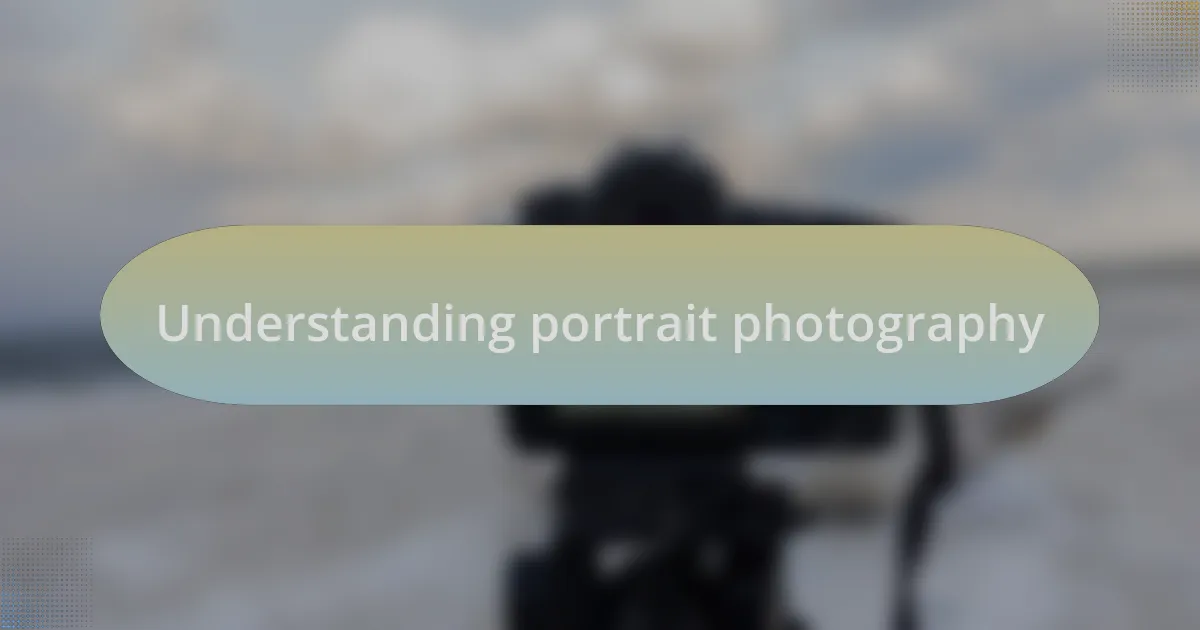
Understanding portrait photography
Portrait photography is more than just capturing a face; it’s about revealing personality and emotion through the lens. I remember one session where I focused not just on the subject but also on their environment. The way light danced around them created a narrative that spoke volumes—what better way to convey someone’s essence than by including elements that matter to them?
The technical aspects, like lighting and composition, are crucial, but they don’t overshadow the importance of connection. When I’m shooting, I often ask my subjects about their stories or experiences. It’s fascinating how these conversations can evoke genuine expressions and candid moments. Have you ever noticed how a simple question can bring out a smile or a thoughtful look?
Then there’s the challenge of portraying vulnerability and strength simultaneously. I often find myself thinking: how can I showcase both sides in a single frame? Sitting with a subject and exploring their emotions allows me to create images that resonate deeply, inviting viewers to connect on an emotional level. There’s something incredibly fulfilling about capturing that duality, don’t you think?
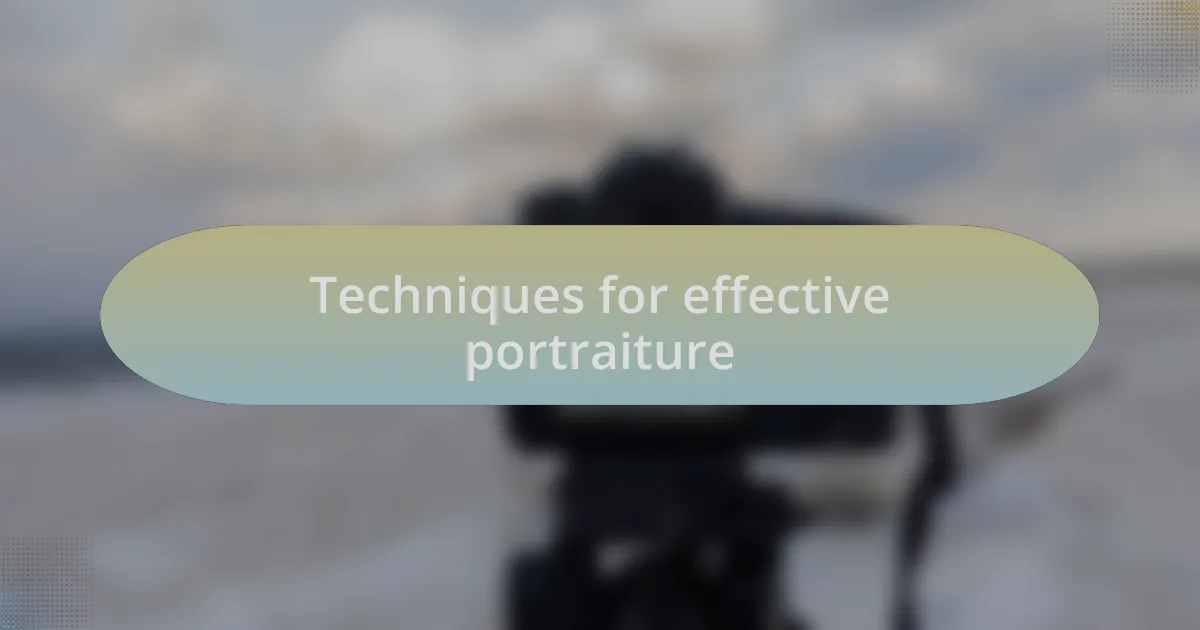
Techniques for effective portraiture
When it comes to effective portraiture, lighting is undoubtedly a critical player. On a recent shoot during golden hour, I found myself mesmerized by how the soft, warm light enveloped my subject, highlighting their features in a completely flattering way. It made me realize that planning the time of day for shooting isn’t just a preference—it’s key to achieving that ethereal quality that draws the viewer in.
Composition is another essential technique that can transform a good portrait into a great one. I distinctly remember experimenting with different angles to elevate my compositions. When I positioned the camera slightly above my subject’s eye level, it not only conveyed a sense of intimacy but also emphasized their unique features. Have you ever tried a shift in perspective to see how it changes the narrative of your images?
Finally, engaging your subject in a way that captures their true essence is vital. I have seen magic happen when I simply asked a subject to reflect on their fondest memory. Their eyes sparkled, and that genuine happiness translated beautifully into the frame. Don’t you find that the best portraits often come from moments of authenticity rather than staged smiles?
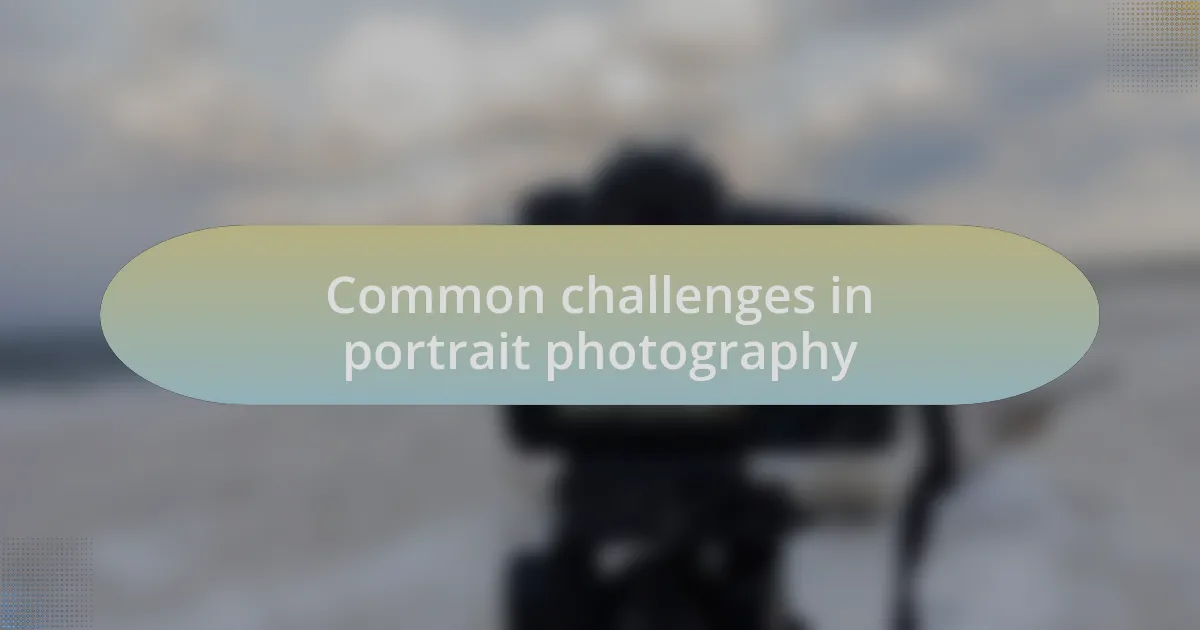
Common challenges in portrait photography
Finding the right expression from a subject can be surprisingly challenging. I recall a session where my model seemed perpetually tense, and no amount of coaxing helped. It was only when I shared a funny story about my own awkward moments in front of the camera that I saw them relax. Have you experienced how just a little vulnerability can break the ice?
Another common hurdle is managing diverse lighting conditions. I once arrived at a location expecting that the natural light would be perfect, only to face a heavy overcast. Instead of being defeated, I decided to embrace the soft light, which created dramatic, moodier images. It’s fascinating how adapting to unexpected lighting can actually lead to unique artistic outcomes, don’t you think?
Lastly, getting the right background often proves tricky. I vividly remember a shoot where I spotted the perfect outdoor setting but quickly realized the busy street behind it was a distraction. I ended up finding a quieter area nearby, which not only complemented my subject but also allowed their personality to shine through without competing elements. How do you usually navigate backgrounds to ensure they enhance rather than detract from your portraits?

My favorite portrait styles
When it comes to portrait styles, I find myself gravitating towards environmental portraits. I love how they tell a story by placing my subjects in familiar surroundings. Once, I captured a musician in his favorite café, where the warm, rustic décor complemented his laid-back vibe. The connection between the subject and their environment can be so powerful, don’t you think?
Another style that resonates with me is the classic black and white portrait. There’s something timeless about stripping away color to focus on the nuances of emotion. I remember photographing an elderly couple, and the way their wrinkles told a love story was mesmerizing. It felt like the absence of color made their bond even more tangible, allowing viewers to feel their history.
I also enjoy experimenting with candid moments during sessions. I often capture laughter or a thoughtful gaze when a subject forgets the camera is there. I had a session where the model was so engrossed in a conversation that I captured a beautiful, unguarded laugh that felt authentic and spontaneous. How often do we miss these fleeting moments in pursuit of the perfect pose? Embracing that spontaneity often results in the most genuine portraits.
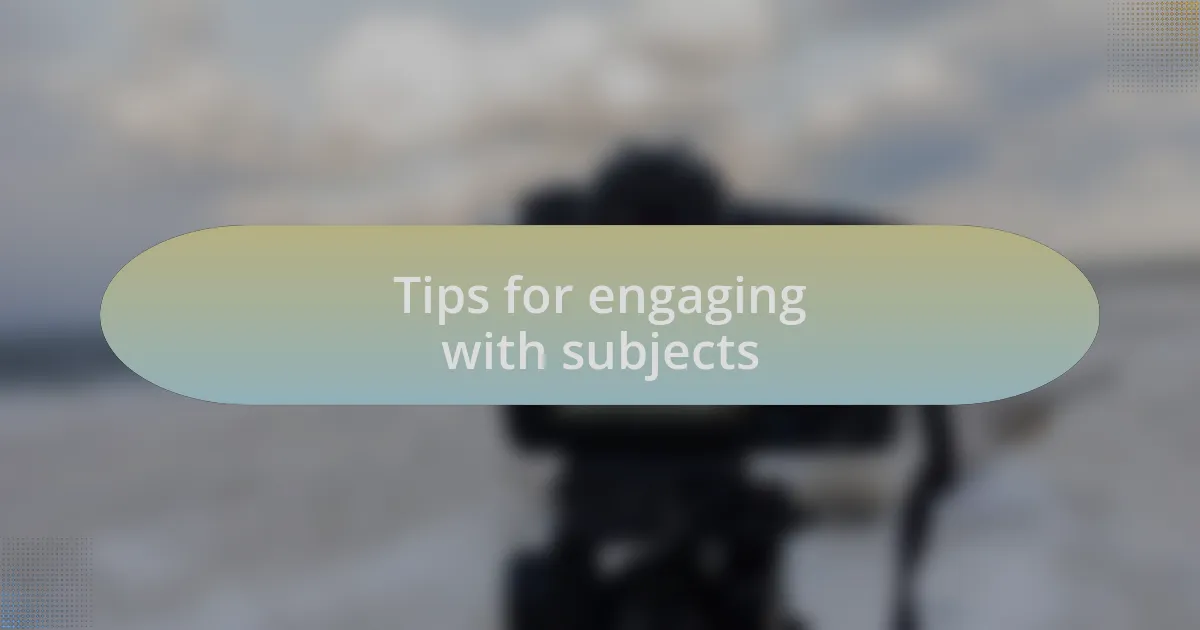
Tips for engaging with subjects
Connecting with your subjects is crucial for capturing authentic moments in portrait photography. One technique I’ve found effective is to start with small talk to ease any tension, especially if the subject is nervous about being in front of the camera. I remember a hesitant teenager during a shoot; we chatted about their favorite music, and when we switched back to photography, the playful energy translated beautifully into their portraits.
Establishing trust can make all the difference in your photography. I once worked with a shy artist who was initially closed-off. I shared a story about my own creative struggles, and suddenly, it felt like we were in the same boat. After that, their personality shone through in every frame—sometimes, it just takes a little vulnerability to break the ice.
Incorporating movement can also enhance engagement. During a recent portrait session, I suggested a fun exercise where the subject twirled or playfully moved around. Not only did it elicit genuine laughter, but it also resulted in some dynamic shots that felt alive. Have you ever considered how a little movement can transform the mood of a portrait? It’s amazing how breaking away from static poses can create more relatable and joyful images.
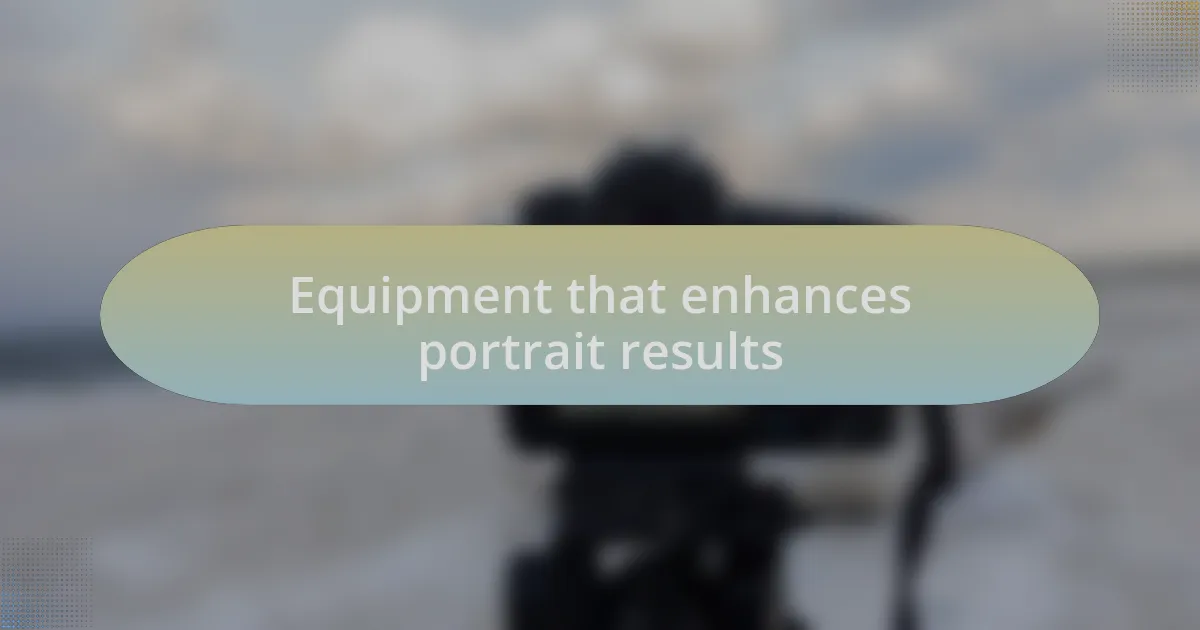
Equipment that enhances portrait results
Choosing the right equipment is critical for enhancing portrait results. I’ve found that a prime lens, especially with a wide aperture like f/1.8 or f/1.4, creates that dreamy bokeh and isolates the subject beautifully. I still recall the first time I used a 50mm lens for a portrait; the way it blurred the background made my subject pop, and the image took on a new level of professionalism.
Lighting equipment also plays a pivotal role in portrait photography. Natural light can be magical, but I’ve discovered that a good external flash or a softbox can transform a flat setting into something special. I remember a late afternoon shoot where clouds filtered the sun, reducing light quality. I set up a softbox to provide a soft fill light, and the portraits turned out vibrant and full of life, capturing my subject’s spirit beautifully.
Don’t underestimate the power of reflectors, either. During a shoot with a young woman outdoors, I used a reflector to bounce sunlight onto her face. The result? Her eyes sparkled, and a natural glow enveloped her, turning an ordinary portrait into something captivating. Have you ever thought about how simple tools can elevate your work? It’s often the little things that create the most significant impact in portrait photography.
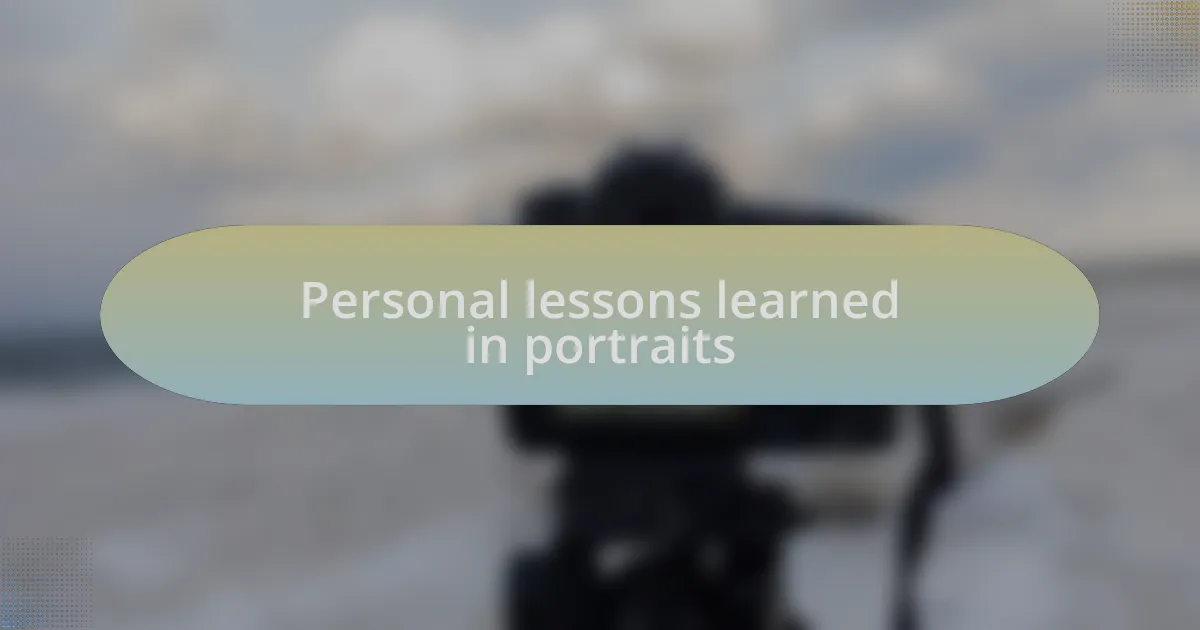
Personal lessons learned in portraits
Capturing a genuine expression has been one of my most rewarding lessons in portrait photography. I remember a session with a shy teenager, where I spent a few minutes just chatting before lifting the camera. By the time I shot the first frame, I had unknowingly captured her laughter, which turned out to be the most enchanting shot of the day. Isn’t it fascinating how the mood you create can dramatically change the outcome of your photos?
Another key lesson I learned is the importance of posing. Initially, I often felt uncertain about how to guide my subjects, but over time, I’ve come to appreciate that simple directions yield extraordinary results. For instance, during one outdoor session, I asked a couple to lean towards each other, and in that instant, their intimacy blossomed into something so palpable it practically radiated from the photograph. Have you ever noticed how a slight adjustment can shift the entire mood of your portraits?
Lastly, I’ve realized that sometimes, it’s those unplanned moments that make for the best portraits. During a family shoot, while setting up my gear, the children started a spontaneous game of tag. Instead of interrupting their play, I decided to capture the laughter and movement. The resulting images were filled with joy and energy, making those candid shots among my favorites. Isn’t it interesting how these unexpected opportunities can lead to our most cherished memories in photography?